
Discovery’s Final Quest Will Take Faith of the Heart
It’s been a long road, getting from there to here. “Here” not just being two years after we last left Star Trek: Discovery rejoicing in the indulgence of a happy ending in its season four finale, but at the beginning of one final adventure for the show that started Trek’s streaming age. But here we are, and while the Discovery we have now is willing to play a bit of a different ball game when it comes to connecting to its sibling shows, there’s also something very clear in this premiere: this is a show that, perhaps finally, is certain of what it’s going to be about.

Discovery’s bumper fifth season premiere today, “Red Directive” and “Under the Twin Moons”, has a lot on its plate, even with the extended runtime to smooth us into that ideas the show wants to play with heading into its final season. And play it does—both these episodes are Discovery on a kind of action kick we’ve rarely seen the show engage with for what, it now seems like, is going to be an extended mode for this season. Sure, Discovery’s done lots of improbable action before, flinging Michael Burnham (Sonequa Martin-Green)’s poor, very put-upon body in these two episodes through the vacuum of space, warp bubbles, desert chases, phaser firefights, and perhaps the worst stressor of all, Starfleet judicial meetings. And sure, the series has built its overarching thread around a hunt for information before, as we have now—when the titular “Red Directive” (a seeming riff on the Omega Directive of Star Trek: Voyager, a secret Starfleet command override that stresses both potent threat and immediate compliance in equal measure) thrusts Discovery’s captain and her crew into the heart of a chase across the galaxy for some all-powerful tech with connections to an all time great Trek story (more on that later).
But this, even with the severity of the stakes that we eventually learn are on the table, is something different. Discovery isn’t on a mission or a quest; it’s on an adventure, and this is a show that has rarely given itself the time to have one of those.
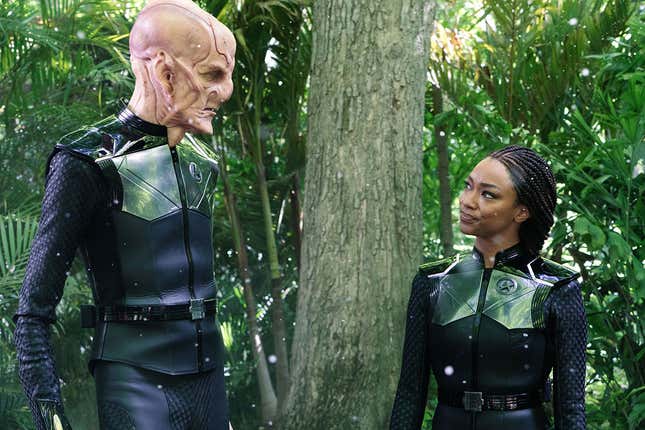
It’s a confidence in finally being content to see its heroes play the part of heroes that suits the series. No longer, it seems, is Discovery going to question whether or not Michael should be the captain that she is, only to prevaricate before ultimately coming to the conclusion that, well, she’s the star of a Star Trek show, she has to be. It’s a show willing to go all in on the bombast and spectacle that—while for the most part still wants you to just shut up and let the lavish stunts and setpieces speak for themselves—still has just enough of a thematic link through to the one message that Discovery will beat over your head until your dying breath: unity and connection with each others will always triumph in the face of overwhelming odds, because that’s worth believing in. It’s a show that is, after years of struggling, starting to mostly get there on realizing that its characters are actually worth building out into different units and combinations and, y’know, treating each other like friends and co-workers instead of people who happen to be standing in the same scene together.
This is a show that’s having fun. And it turns out, it’s rather fun to watch a show that’s having fun.
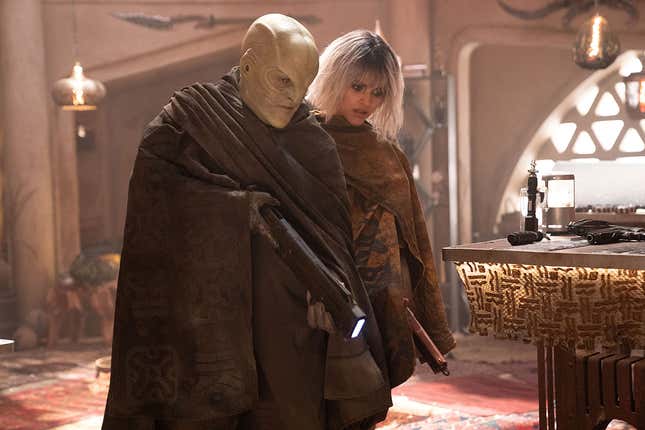
What’s all this fun in service of? Well, two things, both as important as one another. The first is the reveal that this season’s quest—nay, its adventure—picks up on a fascinating thread of Star Trek lore. After being bandied about by Dr. Kovich’s whims and the threat of the “Red Directive” throughout the first episode, chasing two mysterious thieves, Mol and L’ak (Eve Harlow and Elias Toufexis, respectively)—who have uncovered a puzzlebox from rediscovered, 800-year old Romulan science vessel apparently holding the key to an imminent, galaxy-threatening power—Burnham, in her own unstoppable force approach to problem solving, eventually gets the answers she wants. The power Mol and L’ak are now chasing is technology left behind by a race now referred to as the Progenitors: a species that was at the core of the Next Generation season six episode “The Chase,” an ancient, dead civilization that, after clues to their existence led Starfleet, the Klingons, the Romulans, and the Cardassians on a similar merry chase to Burnham’s own adventures (less space dirtbikes that time round though), revealed that they are in fact the common genetic link to every contemporary humanoid civilization in the galaxy.
There, the “treasure” sought by our various factions, believing it to be some great power or weapon, was knowledge of a shared ancestry, and with it, the hope of peace. In the here and now of Discovery’s 32nd century, what’s left behind is the discovery of a purported power that is now indeed perhaps the great weapon the factions of “The Chase” believed they were running after in the first place. That in and of itself is an interesting twist—for better or worse, Discovery loves a dire stake, but explicitly shifting what was in TNG a chase to discover knowledge into the threat of something that could be weaponized in the right hands brushes up against Discovery’s thematic heart about co-operation and unity in ways that are fertile for exploration as the season progresses.
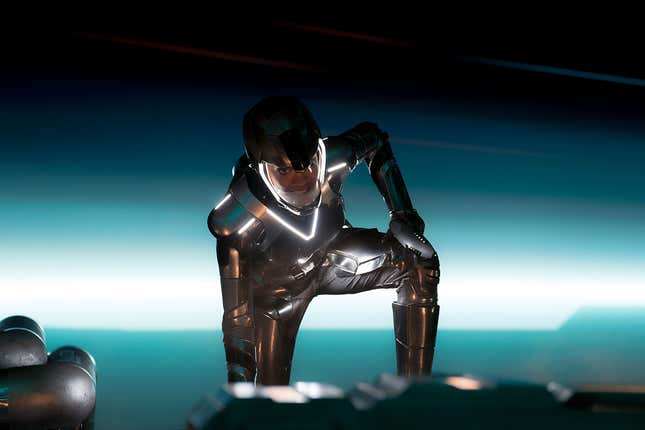
The second thing this fun is all in service of is tinged with a little tweak of sadness—Discovery’s fascination with the ways people connect to each other, and the strength they find in those bonds, is tested through these episodes, and in some ways they are tested in realizing that some of those bonds have to be broken, temporarily or otherwise. On the surface, a lot of “Red Directive” and “Under the Twin Moons” are about that whiz-bang spectacle, as the Discovery (tag-teaming with another Starfleet ship, the Antares, and its Kellerun captain, Rayner, played by Callum Keith Rennie) chases Mol and L’ak across the quadrant in search of more clues to the Progenitor’s puzzle. But underneath that is a tension that focuses around three key couples in particular at first: Saru (Doug Jones) and his flourishing romance with the Vulcan ambassador T’Rina (Tara Rosling), and then with the much frostier link between Michael and Book (David Ajala), who have grown distant in the wake of the latter’s rogue turn during season four, siding with the misguided Dr. Tarka in trying to destroy the Dark Matter Anomaly.
These two storylines focus on the romance that has always been at the heart of the show. For Saru and T’Rina, it’s complicated by Saru receiving an offer from the Federation’s president to become an ambassador for multiple smaller vulnerable member worlds, which would result in him working more closely at Federation Headquarters with T’Rina, but come at the cost of resigning his Starfleet commission and leaving Discovery. For Michael and Book, it’s about each of their own headstrong attitudes, and how, despite the former’s momentary grief in believing she’d lost her lover, his ultimate betrayal of her judgment last season still lingered, and was impacted by his absence when he was assigned to assist with Federation relief efforts across the galaxy as part of his punishment.
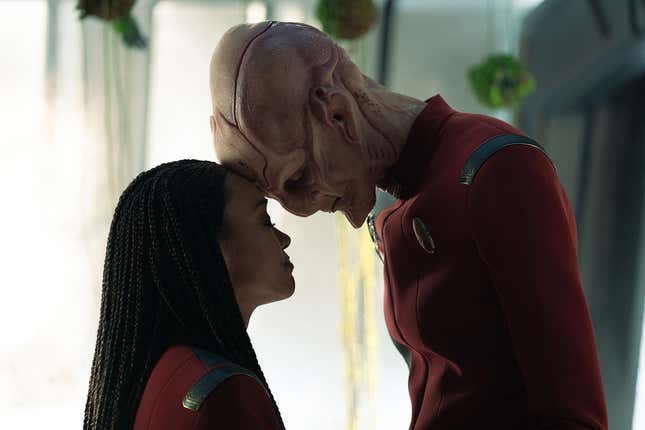
These are two relationships coming at different ends of similar realizations about what the people involved want in their lives. After a dangerous encounter with Mol and L’ak on a desert world saw the Discovery and Antares forced to smash themselves and their shield bubbles into a wall to stop a colony from being wiped out by an avalanche, Saru realizes that he loves T’Rina too much to put her in the position of fearing for his livelihood as the Discovery leads Starfleet’s renewed charge of aiding the galaxy, and cannot logically remove that context from his decision to retire. Michael and Book meanwhile, forced to work together again when it’s realized that Mol and L’ak’s history as couriers makes Book a particular strategic asset in their chase, are both forced to reckon that the love they once had for each other has been damaged severely by the fallout of last season and the time between then and now—and navigate whether or not they want to try and repair things, or navigate the changed feelings they now have for each other. Saru and Michael both pick a sense of duty then, in different ways: Saru decides to leave Discovery, and T’Rina proposes marriage in a lovely little scene (it’s a shame their relationship mostly had to be left to flourish off screen, but it still works). Michael, picks what she loves to pick the most a lot of the time—dedication to a mission she can focus on, instead of really reckoning with all her feelings.
That brings us to the third connection this premiere places a focus on—an intriguing one that will no doubt expand throughout the season. In these episodes we are regularly presented with the aforementioned Antares captain Rayner as a foil to Michael: an annoying one. The duo repeatedly butt heads, question each other’s decisions, and make it very clear that they’re often in disagreement with each other and to everyone around them. Rayner’s hesitancy to let Michael take the lead is what leads to the avalanche threatening the colony, when his own attempts to stop Mol and L’ak from escaping their clutches again inspire the criminals to create a deadly distraction—a mistake that sees Michael and Rayner pulled up in front of Federation and Starfleet officials, and Rayner’s forced retirement. But after one last hurrah mission for Michael and Saru together—Saru even gets to do his wild Kelpien run and shoot things with his little head needles, it’s fun!—and she realizes she needs a new First Officer, she skips over any internal candidates she has on Discovery’s roster and goes right to Rayner. Michael, she argues, needs a challenge as much as she needs an ally: and Rayner won’t pull punches on her because, while he respects her, he doesn’t treat her like the friend Saru does from their years of context with each other.
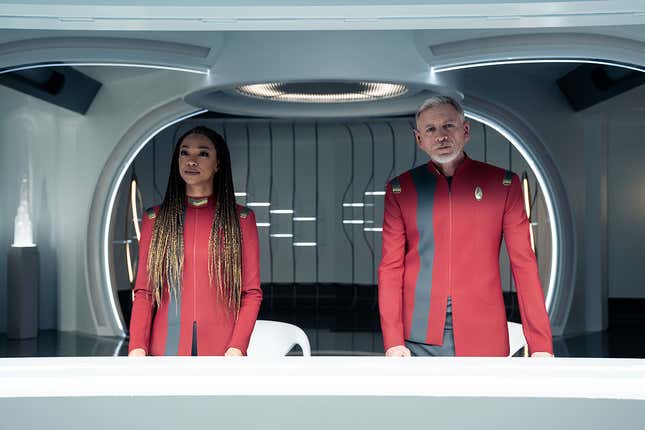
In Rayner’s agreement, we see the earliest sparks of a new connection being forged—the thing Discovery loves to see most. And that will be an important thing to see across this season, as this adventure to find whatever Progenitor tech could threaten all life unfolds—giving the show one last chance to hammer home its beloved message of co-operation and unity, and perhaps, once again, show off a lot of that fun and confidence it’s trying to feel along the way. There’s a lot of promise presented across these two episodes to show that maybe, for one last time, Discovery will pull it all off in the face of impossible odds again.
Star Trek: Discovery streams new episodes Thursdays on Paramount+.
Want more io9 news? Check out when to expect the latest Marvel, Star Wars, and Star Trek releases, what’s next for the DC Universe on film and TV, and everything you need to know about the future of Doctor Who.
اكتشاف المزيد من موقع دبليو 6 دبليو
اشترك للحصول على أحدث التدوينات المرسلة إلى بريدك الإلكتروني.
